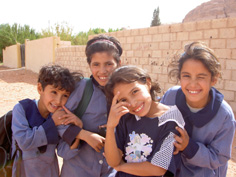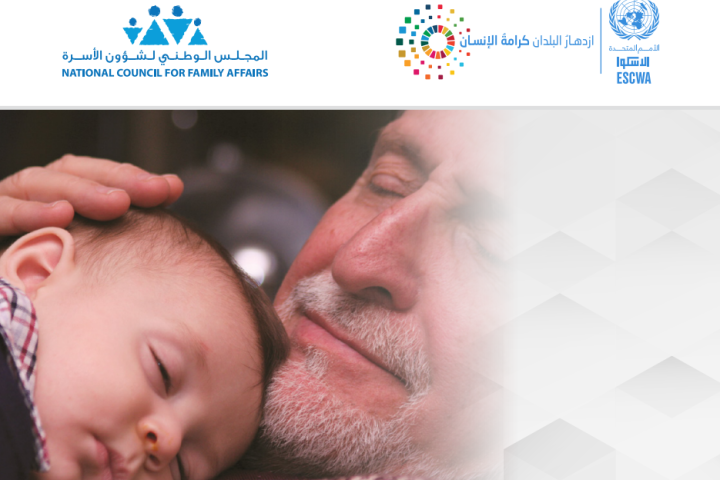Often considered as a single political or religious unit, the Arab world comprises 22 countries that represent all colours of the development spectrum. From oil-rich Gulf countries to the Least Developed countries, the Arab world holds many social and economic disparities.
These disparities are highlighted in the UN-ESCWA-coordinated publication entitled "The Millennium Development Goals (MDGs) in the Arab Region 2007: A Youth Lens An Overview", produced as a result of the collaboration between UN agencies in the region and the League of Arab States (LAS). In advance of the second regional report, this booklet offers a brief overview of progress towards attaining the MDGs in the main subregions of the Arab world: Mashreq (Egypt, Iraq, Jordan, Lebanon, Palestine and the Syrian Arab Republic); Maghreb (Algeria, Libyan Arab Jamahiriya, Morocco and Tunisia); the Gulf Cooperation Council countries (Bahrain, Kuwait, Oman, Qatar, Saudi Arabia and the United Arab Emirates) and the Arab Least Developed Countries or LDCs (Comoros, Djibouti, Mauritania, Somalia, Sudan and Yemen).
The publication reviews MDG progress in the Arab region, goal by goal, based on the latest available data.
1-Eradicate Extreme Poverty and Hunger: Overall, the Arab region has not achieved significant progress in reducing income poverty during the past decade. While the majority of Maghreb and Mashreq countries have succeeded in lowering the proportion of poor people, the Arab LDCs continue to face very high rates. On the other hand, the proportion of people who suffer from hunger and the proportion of underweight children have declined only slightly. Without drastic measures to alleviate poverty and root out hunger, the first MDG goal is endangered.
2- Achieve Universal Primary Education: The progress registered in this area is most revealing in terms of regional disparities. Net enrolment rates in primary education increased by 10% in the Arab region as a whole between 1991 and 2005, and the gender parity index also improved substantially. In the Maghreb and Mashreq, over 90% of children are enrolled in primary schools. Two-thirds of the 7.5 million out-of-school children in the Arab world live in the LDCs and almost one out of three young people is illiterate in these countries. On the up side, the average youth literacy rate in the Arab world has increased by more than 15 percentage points to 83.4% in 2005.
3- Promote Gender Equality and Empower Women: The ratio of girls to boys at all levels of education witnessed a notable rise, but female literacy rates remain relatively low in some Arab countries, particularly in Mauritania and Morocco. Increased access for girls to education has not yet resulted in significantly higher employment rates as a combination of educational, social, and economic factors continue to hinder their participation in the labour market. At the political level women have achieved striking accomplishments in several Arab countries, including GCC countries such as Kuwait, where access to politics is no longer exclusive to men. On the rights front, 18 out of 22 countries in the region ratified the Convention on the Elimination of all forms of Discrimination Against Women (CEDAW). However, the rate of female Arab parliamentarians remains the lowest among the major regions in the world.
4- Reduce Child Mortality: The ratio of under-five child mortality decreased by 27% in the Arab region between 1990 and 2005 Vaccination rates against measles improved to 85% in 2004, a number significantly above the developing regions’ average of 73%. However, in the Arab LDCs more than one in ten children die before reaching the age of five and progress in this matter has remained slow, except in Comoros. Egypt has succeeded in reducing child mortality by 68%, whereas Iraq and Palestine experienced a deterioration of health indicators.
5- Improve Maternal Health: Considerable progress was made on this front, with a decrease of about 34% in the maternal mortality ratio between 1990 and 2000 Less teenage pregnancies and a considerable increase in births attended by skilled personnel have contributed to this improvement. However, countries such as Sudan continue to lag behind, with some 509 deaths per 100,000 live births in 2000.
6- Combat HIV/AIDS, Malaria and other Diseases: The overall prevalence of HIV/AIDS remains low in the Arab countries, but, has been on the rise in recent years. Responding to this threat, countries have adopted Multi-Sectoral National Strategic Plans (NSPs), but more efforts are needed since only around 5% of patients in 2005 had access to anti-retroviral drugs.
Malaria and Tuberculosis remain major challenges in the Arab LDCs, where the former disease affected 3,313 per 100,000 people in 2005. 56% of all new registered Tuberculosis cases in the Arab world were reported in the LDCs
Malaria and Tuberculosis remain major challenges in the Arab LDCs, where the former disease affected 3,313 per 100,000 people in 2005. 56% of all new registered Tuberculosis cases in the Arab world were reported in the LDCs
7- Ensure Environmental Sustainability: While Saudi Arabia created one of the largest protected areas in the world, the Arab LDCs, which have the highest biological diversity in the subregion decreased their proportion of protected zones. Major environmental challenges in the Arab world include the strong increase in population, a drastic surge in carbon-dioxide emissions as well as ozone-depleting substances and a rise in energy consumption. Meanwhile, the proportion of people using improved drinking water remained the same, but access to better sanitation facilities did improve, albeit slowly.
8- Develop a Global Partnership for Development: A wide gap in trade volumes and ratios exists between Arab countries, while these trade volumes account for a small share in total world trade. GCC countries account by far for the biggest share of the region’s total exports and imports, while LDCs hold a minimal one. On the other hand, factors such as geopolitical reasons and past colonial ties tend to play a major role in the allocation of aid flows to the region, restricting the amount that actually reaches,the poorest countries. Young Arab men and women, meanwhile, suffer from extremely high un- and underemployment rates and very difficult market labour conditions. In 2005, around 25% of Arab youth were unemployed, a rate three times higher than that for adults. As for new technologies, they have reached a considerably larger share of the population in the Arab world during the past decade. However, disparities between individual Arab countries remain very high, with the digital divide being most noticeable when comparing access to information and communication technology in the GCC countries and the Arab LDCs.
The MDG booklet is the result of a collaborative effort between the following organizations that was coordinated by UN-ESCWA:
League of Arab States: www.arableagueonline.org
Jordan Centre for Public Policy Research and Dialogue: www.jcpprd.org
Food and Agriculture Organization of the United Nations: www.fao.org
International Labor Organization- Regional Office for Arab States: www.ilo.org
Office of the High Commissioner for Human Rights: www.ohchr.com
Joint United Nations Programme on HIV/AIDS: www.unaids.org
United Nations development Programme- Subregional resources Facility for the Arab States: www.undp.org
United Nations Educational, Scientific and Cultural Organization- Regional Bureau for Education in the Arab States: www.unesco.org
UNESCO Institute for Statistics: www.uis.unesco.org
United Nations Environment Programme- Regional Office for West Asia: www.unep.org
United Nations Population Fund: www.unfpa.org
United Nations Children’s Fund- Regional office for the Middle East and North Africa: www.unicef.org
United Nations Industrial Development Organization: www.unido.org
United Nations Development Fund for Women – Arab States Regional Office: www.unifem.org
World Food Programme- Regional Bureau for the Middle East and North Africa: www.wfp.org
World Health organization- Regional Office for the Eastern Mediterranean: www.who.org
Jordan Centre for Public Policy Research and Dialogue: www.jcpprd.org
Food and Agriculture Organization of the United Nations: www.fao.org
International Labor Organization- Regional Office for Arab States: www.ilo.org
Office of the High Commissioner for Human Rights: www.ohchr.com
Joint United Nations Programme on HIV/AIDS: www.unaids.org
United Nations development Programme- Subregional resources Facility for the Arab States: www.undp.org
United Nations Educational, Scientific and Cultural Organization- Regional Bureau for Education in the Arab States: www.unesco.org
UNESCO Institute for Statistics: www.uis.unesco.org
United Nations Environment Programme- Regional Office for West Asia: www.unep.org
United Nations Population Fund: www.unfpa.org
United Nations Children’s Fund- Regional office for the Middle East and North Africa: www.unicef.org
United Nations Industrial Development Organization: www.unido.org
United Nations Development Fund for Women – Arab States Regional Office: www.unifem.org
World Food Programme- Regional Bureau for the Middle East and North Africa: www.wfp.org
World Health organization- Regional Office for the Eastern Mediterranean: www.who.org




